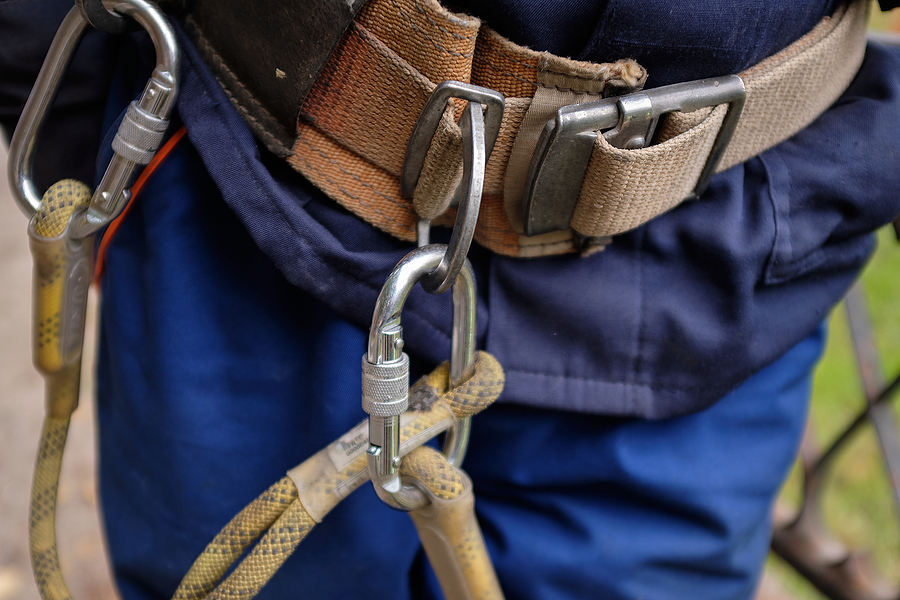Top 5 Construction Fall Prevention Tips

Working on elevated surfaces is part of the job for many construction workers. But it also makes falls the number one killer in the industry. You slip, trip or lose your balance up high, and the results can be catastrophic. Not to scare you, but 401 construction workers died in 2019 from falls alone.
The good news? Every one of those construction falls was preventable. Yes, you heard that right – with proper safety precautions, equipment and training, experts say construction workers can prevent dangerous tumbles off rooftops, scaffolding, ladders and more. Keep reading to learn the top 5 tips to save your life working at heights.
#1 Always Clip In Your Full Body Harness
Let’s start with the obvious must-do: wearing a safety harness connected to an anchor point with a lanyard or lifeline. Industry safety regulations require it for good reason. that harness could be the only thing between you and a deadly plunge if you slip and fall.
OSHA says all construction workers must use a body harness system when working at the following heights:
- 6 feet or above for steel erection
- 6 feet or above at the perimeter of a building
- Hoist areas
- Excavations greater than 6 feet deep
- Wall openings with drops over 6 feet
When you clip in, double check:
- The harness fits snugly with all straps tightened
- The D-ring rests in the middle of your back
- Connect to the anchor point before going near the edge
This may sound basic, but many deadly falls happen when workers disconnect from anchor points to reach farther. Never unclip until you’re safely away from the edge!
#2 Inspect All Equipment Thoroughly Before Use
You trust your safety harness, anchors, lanyards and other gear to save you in a fall. But what if unseen wear and tear causes them to fail when you need them most?
Before starting any job involving heights, inspect all equipment with these steps:
- Hold lanyards and lifelines up to light, looking closely for cuts, burns, abrasions. Check stitching for pulled threads.
- Examine harness straps and D-rings closely for fraying, breaks or cracks.
- Ensure hooks and clips aren’t cracked or broken. Check gates/keepers to make sure they close.
- Confirm expiration dates haven’t passed.
- Check anchor points are solid and secure.
Don’t forget the routine inspection every 6 months by a competent site safety manager. They will thoroughly examine and test each component.
If damage compromises integrity even slightly, remove the gear from service. Don’t risk failure in preventing a fatal fall!
#3 Install Guardrails Or Covers For All Holes & Openings
Imagine carrying a heavy load toward a rooftop access point, eyes down, focused on not dropping it. You step through the doorway and suddenly …there’s nothing under your feet but a gaping hole. You plunge 30 feet straight down before slamming into the concrete floor below.
This dangerous scenario happens too often on construction sites. Workers fall through skylights, ventilation shafts, stairwell openings or other holes. Many suffer severe injuries or die.
Guardrails provide an easy, reliable way to prevent such falls. Install guardrails:
- Along any open side or edge of a walking/working surface 6 feet or more above a lower level
- Around holes, wall openings, skylights – anything with a fall potential over 6 feet.
- Made of wood or metal, with a midrail, toe board and posts not more than 8 feet apart.
- Strong enough for workers to grab safely if they trip or slip near the edge.
For smaller holes, use hole covers clearly marked “HOLE” or “COVER.” They must support at least twice the weight of workers and equipment passing over them.
#4 Removing Trip Hazards Prevents Loss-Of-Balance Falls
Falls don’t only happen from elevated work surfaces. Same-level trips and slips also cause many deaths and injuries among construction workers every year. Obstructions, clutter, debris and uneven surfaces present common hazards.
Minimize the risks by following good housekeeping practices:
- Keep walkways and work areas clear of materials, tools, wires and other obstructions.
- Make sure concrete flooring is smooth, even and free of loose boards or bricks.
- Mark sudden changes in surface height with warning signs or safety cones.
- Provide good lighting everywhere workers are present, especially stairs.
- Keep stair treads and risers uniform and equip with grip tape and railings.
#5 Pre-Shift Safety Meetings Remind Workers To Stay Alert
Short, daily pre-shift safety meetings combat this tunnel vision tendency. Use 5-10 minutes to:
- Review fall hazards unique to that day’s sites and activities
- Demonstrate proper use of equipment like lanyards, safety nets, guardrails
- Remind everyone to stay connected to anchors at all times
- Recognize workers who caught and corrected trip hazards the day before
When everyone hears frequent tips to avoid falls, it stays top of mind all shift long. Stats show work crews with better safety communication have lower incidence of accidents and fatalities.
Final Thoughts
Falls cut lives tragically short in the construction industry every single day. But if you learned here, they DON’T have to! Following these 5 tips religiously will help ensure you clock out safe each day, ready to return home to your family after a hard day’s work.
